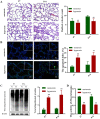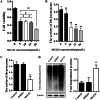The function role of ubiquitin proteasome pathway in the ER stress-induced AECII apoptosis during hyperoxia exposure
- PMID: 34809635
- PMCID: PMC8607682
- DOI: 10.1186/s12890-021-01751-9
The function role of ubiquitin proteasome pathway in the ER stress-induced AECII apoptosis during hyperoxia exposure
Abstract
Background: Bronchopulmonary dysplasia (BPD) is a major cause of mortality and morbidity in premature infants, characterized by alveolar dysplasia and pulmonary microvascular remodeling. In the present study, we have investigated the functional roles of ubiquitin proteasome pathway (UPP) in BPD, and its relationship with endoplasmic reticulum stress (ERS) mediated type II alveolar epithelial cell (AECII) apoptosis.
Methods: A hyperoxia-induced BPD rat model was constructed and the pathologic changes of lung tissues were evaluated by hematoxylin-eosin staining. Cell apoptosis and protein expression were determined by TUNEL assay and Western blotting, respectively. Further reagent kit with specific fluorescent substrate was utilized to measure the activity of 20 s proteasome. Meanwhile, AECII were cultured in vitro and exposed to hyperoxia. AECII apoptosis were measured by flow cytometry. In contrast, MG132 treatment was induced to explore UPP during hyperoxia exposure on AECII apoptosis and ERS sensors expression.
Results: A significant increase in apoptosis and total ubiquitinated proteins expression were observed in BPD rats and AECII culture, and the change of UPP was associated with ERS. In order to confirm the role of UPP in AECII apoptosis of BPD, AECII cells were treated by MG132 with the concentration of 10 μmol/L under hyperoxia exposure. We found that the proteins expression of glucose-regulated protein 78 (GRP-78), PKR-like ER kinase (PERK), activating transcription factor 4 (ATF4), activating transcription factor 6 (ATF6) and C/EBP homologous protein (CHOP), as well as AECII apoptosis were increased following MG132 treatment. Furthermore, the relatively up-regulated in the levels of total ubiquitinated proteins expression and 20 s proteasome activity were correlated with increased ERS sensors expression.
Conclusions: Our findings indicate that UPP may participate in the ERS-induced AECII apoptosis under hyperoxia condition.
Keywords: Alveolar epithelial type II cells; Apoptosis; Bronchopulmonary dysplasia; Endoplasmic reticulum stress; Ubiquitin proteasome pathway.
© 2021. The Author(s).
Conflict of interest statement
Not applicable.
Figures






Similar articles
-
[Hyperoxia induces AECII apoptosis of premature rats by reducing the activity of 20S proteasome].Xi Bao Yu Fen Zi Mian Yi Xue Za Zhi. 2016 Dec;32(12):1600-1604. Xi Bao Yu Fen Zi Mian Yi Xue Za Zhi. 2016. PMID: 27916088 Chinese.
-
Activation of the endoplasmic reticulum stress pathway involving CHOP in the lungs of rats with hyperoxia‑induced bronchopulmonary dysplasia.Mol Med Rep. 2015 Sep;12(3):4494-4500. doi: 10.3892/mmr.2015.3979. Epub 2015 Jun 22. Mol Med Rep. 2015. PMID: 26099737
-
[Association between endoplasmic reticulum stress pathway mediated by inositol-requiring kinase 1 and AECII apoptosis in preterm rats induced by hyperoxia].Zhongguo Dang Dai Er Ke Za Zhi. 2016 Sep;18(9):867-873. doi: 10.7499/j.issn.1008-8830.2016.09.016. Zhongguo Dang Dai Er Ke Za Zhi. 2016. PMID: 27655546 Free PMC article. Chinese.
-
[Methods for establishing animal model of bronchopulmonary dysplasia and their evaluation].Zhongguo Dang Dai Er Ke Za Zhi. 2017 Jan;19(1):121-125. doi: 10.7499/j.issn.1008-8830.2017.01.020. Zhongguo Dang Dai Er Ke Za Zhi. 2017. PMID: 28100335 Free PMC article. Review. Chinese.
-
Endoplasmic Reticulum Stress in Bronchopulmonary Dysplasia: Contributor or Consequence?Cells. 2024 Oct 26;13(21):1774. doi: 10.3390/cells13211774. Cells. 2024. PMID: 39513884 Free PMC article. Review.
Cited by
-
IRF4-mediated Treg phenotype switching can aggravate hyperoxia-induced alveolar epithelial cell injury.BMC Pulm Med. 2024 Mar 15;24(1):130. doi: 10.1186/s12890-024-02940-y. BMC Pulm Med. 2024. PMID: 38491484 Free PMC article.
-
ILC2 regulates hyperoxia-induced lung injury via an enhanced Th17 cell response in the BPD mouse model.BMC Pulm Med. 2023 May 30;23(1):188. doi: 10.1186/s12890-023-02474-9. BMC Pulm Med. 2023. PMID: 37254088 Free PMC article.
-
LncRNA gadd7 promotes mitochondrial membrane potential decrease and apoptosis of alveolar type II epithelial cells by positively regulating MFN1 in an in vitro model of hyperoxia-induced acute lung injury.Eur J Histochem. 2023 May 31;67(2):3535. doi: 10.4081/ejh.2023.3535. Eur J Histochem. 2023. PMID: 37254890 Free PMC article.
-
Post-translational modifications and bronchopulmonary dysplasia.Front Pediatr. 2025 Jan 3;12:1426030. doi: 10.3389/fped.2024.1426030. eCollection 2024. Front Pediatr. 2025. PMID: 39830627 Free PMC article. Review.
-
A predictive model for preterm infants with bronchopulmonary dysplasia based on ferroptosis-related lncRNAs.BMC Pulm Med. 2023 Oct 2;23(1):367. doi: 10.1186/s12890-023-02670-7. BMC Pulm Med. 2023. PMID: 37784105 Free PMC article.
References
-
- Tanaka T, Saito Y, Matsuda K, Kamio K, Abe S, Kubota K, Azuma A, Gemma A. Cyclic mechanical stretch-induced oxidative stress occurs via a NOX-dependent mechanism in type II alveolar epithelial cells. Respir Physiol Neurobiol. 2017;242:108–116. - PubMed
MeSH terms
Substances
Grants and funding
LinkOut - more resources
Full Text Sources
Research Materials
Miscellaneous

